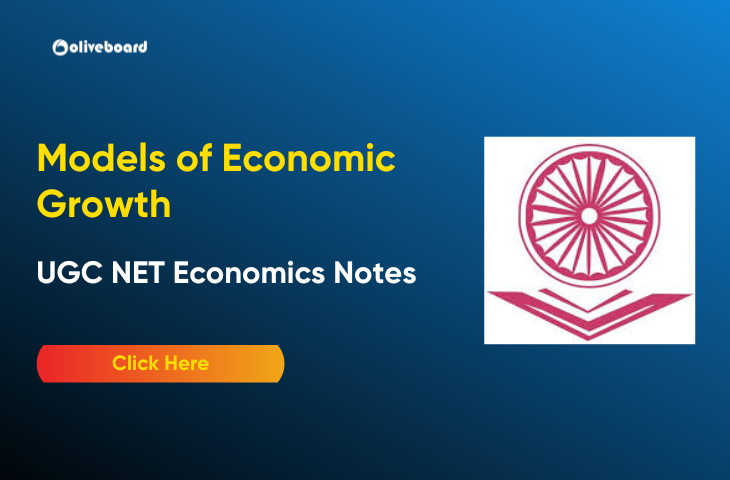Models of Economic Growth: Models of Economic growth is a fundamental concept in economics, offering insights into how nations develop over time by increasing their production and improving living standards. Understanding the theoretical underpinnings of economic growth is crucial for UGC NET Economics aspirants, particularly within UGC NET Economics Unit 8 syllabus. This article explores prominent UGC NET Economic notes on Harrod-Domar model, Solow model, Robinson model, and Kaldor model, with a focus on their significance, assumptions, and implications for economic policy.
Models of Economic Growth – Harrod-Domar Model
The Harrod-Domar Model is a foundational theory in economic growth, introduced independently by Sir Roy Harrod (1939) and Evsey Domar (1946).
Overview and Assumptions of Harrod-Domar Model
- Linear Relationship: Economic growth depends directly on the rate of savings and the productivity of capital.
- Constant Returns to Scale: The production function assumes no diminishing returns to capital.
- Fixed Capital-Output Ratio (v): A constant ratio between capital stock and output.
- Exogenous Savings Rate (s): The savings rate is determined outside the model.
- No Technological Change: The model does not account for technological progress.
- Full Employment: It assumes labor and resources are fully utilized.
Core Equations: Savings, Investment, and Growth Dynamics
1. Savings Equation:
S = sY
Total savings (S) are a fixed proportion (s) of national income (Y).
2. Investment Equation:
I=ΔK
Investment (I) equals the change in capital stock (ΔK).
3. Capital-Output Relationship:
ΔK=vΔY
The required capital (v) to produce one unit of output (ΔY).
4. Growth Rate:
g= s/v
The growth rate (g) depends on the savings rate (s) and the capital-output ratio (v).
Implications and and Limitations of Harrod-Domar Model
Implications of Harrod-Domar Model
- Role of Savings: Higher savings lead to greater investments, driving economic growth.
- Capital Intensity: Economies with lower capital-output ratios grow faster with the same savings rate.
Limitations of Harrod-Domar Model
- Neglects the role of technological progress in long-term growth.
- Assumes constant returns to scale, which may not hold in real economies.
- Unrealistic assumption of full employment and fixed capital-output ratio.
Application of Harrod-Domar Model in Policy-Making and Development Planning
The Harrod-Domar model influenced the economic planning of developing countries in the mid-20th century, particularly in post-war reconstruction and early development strategies. Here are its application:
- Planned Economies: India’s Second Five-Year Plan (1956-1961) relied on Harrod-Domar principles to emphasize savings and investments.
- International Aid: The model underscores the need for foreign capital to bridge savings gaps in underdeveloped economies.
Solow Model (Neoclassical Growth Theory)
The Solow Growth Model, developed by economist Robert Solow in 1956, is a landmark theory in economic growth. It extends the Harrod-Domar model by introducing technological progress and variable factor proportions.
Key Features and Assumptions of Solow Growth Model
- Production Function: Incorporates a Cobb-Douglas production function 𝑌 = A.F (K,L), where Y is output, K is capital, L is labor, and A is technology.
- Diminishing Returns: Marginal returns to capital and labor decrease as their quantities increase.
- Exogenous Technological Progress: Technology (A) grows at a constant rate, independent of other factors.
- Savings and Investment: A fixed portion of output is saved and reinvested in capital.
- Constant Returns to Scale: Doubling capital and labor leads to a doubling of output.
- No Population Constraints: Labor grows at a constant exogenous rate.
Concept of Steady-State Growth and Golden Rule of Capital
1. Steady-State Growth:
The economy reaches a point where capital per worker (k) and output per worker (y) grow at the same rate as technology, ensuring stable economic growth.
Δk=s⋅f(k)−(n+δ)⋅k
Here, s is the savings rate, n is labor growth, and δ is depreciation.
2. Golden Rule of Capital:
The optimal level of capital per worker maximizes steady-state consumption. This occurs when 𝑀𝑃𝐾 = 𝑛+𝛿, where MPK is the marginal product of capital.
Role of Technological Advancement in Long-Term Growth
- Technological progress (A) is the primary driver of sustained economic growth in the Solow model.
- Even as capital accumulation faces diminishing returns, advancements in technology ensure higher productivity and output.
- Innovations shift the production function upward, enabling the economy to grow beyond the steady-state.
Key Facts of Solow Growth Model
- Solow received the Nobel Prize in Economics (1987) for his contributions to growth theory.
- The model predicts conditional convergence, meaning poorer countries can catch up to richer ones if they share similar savings rates, population growth, and technology.
- A significant policy implication is the importance of investing in research, innovation, and education to sustain long-term growth.
Joan Robinson’s Model of Economic Growth
The Joan Robinson Model, introduced in the 1950s, is a key contribution to post-Keynesian economics. It emphasizes the dynamic interaction between capital accumulation, labor growth, and income distribution in driving economic growth.
Context of Joan Robinson’s Model of Economic Growth
- Robinson developed her model to address the limitations of neoclassical growth theories, focusing on real-world complexities like income inequality and imperfect competition.
- Growth in Robinson’s model is driven by capital accumulation, which depends on savings and investment rates.
- Labor force growth and the capital-labor ratio are critical, as imbalances can lead to unemployment or underutilized resources.
- Unlike fixed relationships in neoclassical models, Robinson allowed for variable capital-output and capital-labor ratios.
Key Facts of Joan Robinson’s Model of Economic Growth
- Robinson’s model influenced heterodox economic thought, inspiring further critiques of mainstream theories.
- She authored “The Accumulation of Capital” (1956), a seminal work on growth economics.
- Her approach is central to post-Keynesian growth theories, highlighting the socio-political context of economic processes.
Kaldor’s Model of Economic Growth
Developed by Nicholas Kaldor in the 1950s and 1960s, Kaldor’s growth model emphasizes the relationship between economic growth, capital accumulation, and income distribution.
Kaldor’s Growth Laws
- Growth and Manufacturing: Economic growth is positively correlated with the expansion of the manufacturing sector.
- Capital Accumulation: The growth of capital stock drives output and productivity.
- Productivity and Output: Productivity growth increases with higher output levels, highlighting economies of scale.
Interaction Between Growth, Capital Accumulation, and Income Distribution
- Savings and Investment: Higher income for capital owners leads to increased savings, fostering greater capital accumulation.
- Dual Role of Income Distribution: Income inequality affects both consumption patterns and the savings rate, influencing growth dynamics.
- Demand-Supply Link: Growth depends on the balance between demand (consumption and investment) and productive capacity.
Implications for Structural Transformation in Economies
- Shift to Industry: Kaldor’s model underscores the importance of industrialization for sustained growth.
- Developing Economies: The model is particularly relevant for developing countries transitioning from agrarian to industrial economies.
Key Facts of Kaldor’s Model of Economic Growth
- Kaldor’s theories contributed to post-Keynesian economics and growth policy debates.
- His work influenced industrial strategies in developing nations during the mid-20th century.
- Known for the “Kaldor-Verdoorn Law”, which links productivity growth to output growth.
Models of Economic Growth Comparative Analysis
| Aspect | Harrod-Domar Model | Solow Model | Joan Robinson’s Model | Kaldor’s Model |
| Year | 1939 (Harrod), 1946 (Domar) | 1956 | 1950s | 1950s-1960s |
| Key Assumptions | Fixed capital-output ratio, no technological progress, constant savings rate | Diminishing returns to capital, exogenous technological progress, steady-state growth | Flexible capital-output ratios, focus on effective demand | Focus on manufacturing sector, economies of scale, increasing returns |
| Focus Area | Role of savings and investment in growth | Long-term growth through capital, labor, and technology | Capital accumulation, labor dynamics, and income distribution | Structural transformation, industrialization, and productivity growth |
| Policy Implications | Emphasis on savings and investment rates; suitable for planning in developing economies | Importance of technological advancement and population growth control | Policies addressing income distribution and effective demand | Promotes industrial policies and structural change to sustain growth |
| Treatment of Technology | Not considered | Exogenous, drives long-term growth | Not explicitly addressed | Implicit in economies of scale and productivity gains |
| Critique of Neoclassical Theories | No direct critique, but simpler framework | Forms part of neoclassical tradition | Critiques assumptions of equilibrium and marginal productivity | Critiques equilibrium focus, emphasizes real-world structural dynamics |
| Contribution to Modern Growth Theory | Foundation for early development planning | Basis for endogenous growth models, like Romer’s theory | Inspiration for post-Keynesian growth theories | Insights into structural change and its role in economic development |
Models of Economic Growth Conclusion
In conclusion, understanding Models of Economic Growth, including the Harrod-Domar, Solow, Robinson, and Kaldor models, is essential for mastering UGC NET Economics Unit 8 syllabus. These models provide valuable insights into economic growth dynamics, from savings and technological progress to income distribution and structural transformation. Their contributions form the foundation of modern growth theories, aiding both theoretical analysis and policy-making for sustainable development.
Get Free UGC NET Commerce Notes (Latest Pattern)
Models of Economic Growth FAQs
Ans: The major models of economic growth include the Harrod-Domar Model, Solow Model, Joan Robinson’s Model, and Kaldor Model.
Ans: The Harrod-Domar Model emphasizes the relationship between savings, investment, and economic growth, proposing that growth depends on the level of investment and the capital-output ratio.
Ans: The Solow Model focuses on the role of capital, labor, and technological progress in long-term economic growth, emphasizing steady-state growth driven by technological advancements.
Ans: The Models of Economic Growth are integral to understanding economic growth dynamics and are a key part of the UGC NET Economics Unit 8 syllabus, especially regarding development economics and growth theory.

Hello there! I’m a dedicated Government Job aspirant turned passionate writer & content marketer. My blogs are a one-stop destination for accurate and comprehensive information on exams like Regulatory Bodies, Banking, SSC, State PSCs, and more. I’m on a mission to provide you with all the details you need, conveniently in one place. When I’m not writing and marketing, you’ll find me happily experimenting in the kitchen, cooking up delightful treats. Join me on this journey of knowledge and flavors!
